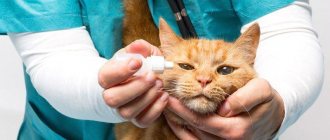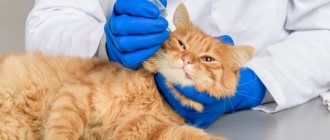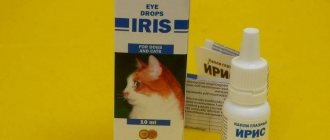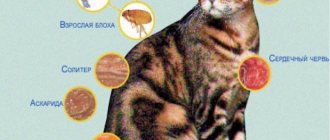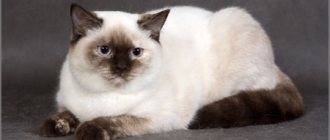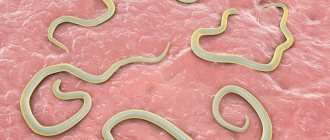Eye drops for cats: indications
The prescriptions for the use of various eye drops in cats are similar, so it is possible to generalize the recommendations for their use.
Anandin for cats
The medicine is prescribed in this form in the following cases:
- infected injuries of the organs of vision (in complex treatment);
- preparing a cat for ophthalmic surgery;
- prevention of complications after eye surgery;
- conjunctivitis of various natures and forms;
- keratitis;
- blepharitis;
- inflammatory processes in the nasolacrimal ducts.
The manifestations of many eye pathologies in cats are similar, which is why trying to self-medicate is quite dangerous. In case of severe lesions, drops are used only in complex therapy in parallel with antibiotic injections.
Treatment methods
It is important to remember that the success of recovery directly depends on the accuracy of the diagnosis and the person’s willingness to fully comply with the instructions.
Recommendations:
- For a complete diagnosis, the doctor requires an anamnesis, i.e. information about the cat: what conditions the pet lives in, its diet, previous diseases, behavioral characteristics, proximity to other animals.
- It is advisable to wash your cat’s eyes with a warm chamomile solution before visiting the veterinary clinic.
- Depending on the causes of suppuration, the doctor may use several treatment approaches. In case of prolonged and profuse discharge from the eyes and nose, as a rule, a novocaine blockade with the administration of an antibiotic is prescribed. If discharge from the eyes is the result of mechanical damage, use Levomycetin drops for an adult cat or Albucid for one-month-old kittens.
Directions for use: how to instill eye drops into a cat
For an animal, the number of instillations per day depends on the prescribed drug, general condition and the instructions of the veterinarian.
The method by which the composition is administered is the same for all types of eye drops. Before instillation, the eyes are washed using a furatsilin solution, a special lotion or saline solution.
A drop of the composition is instilled into each eye of the cat under the lower eyelid.
Ciprovet for cats
A large dosage is not required, as the product will flow out. If the animal responds calmly to treatment, then the bottle can be presented from any side. For cautious pets who are afraid of manipulation, the drops are brought to the eye from the back of the head so that they cannot see anything and become nervous.
When treating an aggressive animal, it is advisable to perform procedures with an assistant. The cat is wrapped in a thick blanket or tucked into the sleeve of a jacket.
While one person is holding the animal, the second is burying it. If the cat categorically does not allow eye drops, you should consult a veterinarian, since there is a high probability that the pet simply cannot tolerate the prescribed drug.
Be sure to read:
Canephron for cats: instructions for use, price, reviews, analogues
What to do if a kitten’s eyes fester: first aid and treatment
The first thing you need to do is wash the kitten's eyes. At home, this can be done with a gauze swab moistened with chamomile decoction or brewing loose-leaf black tea. If there is no effect from washing, you should show your pet to a veterinarian.
How to wash a kitten's eyes if they fester
The choice of rinsing agent depends on the cause of the suppuration. How to treat a kitten whose eyes are festering cannot be said without a veterinarian’s opinion. Only a doctor has the right to prescribe certain medications and calculate the dosage. What the vet usually recommends:
- If the eyelids are bruised or wounded, the damaged part is cleaned with a solution of hydrogen peroxide. Sometimes rinsing alone is not enough - injections or tablets may be prescribed.
- If the discharge is caused by a cold, then the kitten is provided with a dry and warm sleeping place, without drafts and hypothermia, vitamins are added to the diet and eye drops are prescribed from a veterinary pharmacy (Leopard, Iris, etc.).
- If the crusts interfere with the opening of the eyes, they are softened and removed with petroleum jelly.
- Before instillation, the eyes are washed with a weak solution of furatsilin, and hydrogen peroxide is used to treat the skin around the eyes. For severe infections, antibiotics are prescribed. Most drugs are used topically as eye drops.
If the kitten has contracted the virus, then therapy will focus on expelling it from the body. After recovery, the eyes will return to normal on their own - the purulent discharge will stop. A sick baby will have to be injected with antiviral drugs, antibiotics, vitamin complexes, and in case of exhaustion, nutritional droppers will be needed.
Drops and ointments
If discharge from the eyes is caused by a malfunction of the internal organs or viruses, the drops will be an auxiliary treatment that relieves unpleasant symptoms. Eye diseases are mainly treated with drops and ointments.
For localized purulent discharge from the eyes, the following ointments are used: tetraclycine, erythromycin, chloramphenicol, sofradex, misofen and others. They last longer than drops due to their dense consistency, and are usually used 2 times a day for no more than two weeks.
Drops from a veterinary pharmacy are Iris, Bars, Dekta, Tsiprovet, Barrier, etc. They wash out faster, but are easier to use than ointment. Drops are prescribed as a primary or additional remedy that relieves itching and inflammation and washes the pet's eye.
For more serious conditions, such as purulent conjunctivitis, your veterinarian may prescribe antibiotics. The treatment regimen will directly depend on the type of inflammation.
The main thing: do not self-medicate! This can only make things worse.
How to properly rinse and apply eye drops
Remember that before applying the medications you need to clear the eye of pus and discharge. To do this, just take a cotton pad, moisten it in a solution of furatsilin or saline and move it from the outer corner (from the ear) to the inner one. There should be a separate cotton pad for each eye.
To put drops in a kitten’s eyes without harming or scaring him, you need to wrap him in soft cloth, lay him with his muzzle up and raise his head so that his eyes look straight. After this, the lower eyelid of the diseased eye is slightly pulled back and the drug is applied to the mucous membrane.
If the drug is in the form of a thick ointment, you can cover the eye and lightly massage it through the eyelid so that the medicine spreads better over the cornea.
Even a small kitten can resist an unpleasant procedure. Therefore, if you have a very restless or fearful baby, invite an assistant: he will hold the kitten’s head while you drip the medicine. This will save you from nerves, and the kitten from stress and accidental injuries.
What eye diseases are common in cats?
The main eye pathologies in cats are:
- Conjunctivitis - when the disease occurs, inflammation of the mucous membrane of the eyelids occurs. The reasons for the development of the disease are varied - from dirt getting into the eye to infection.
- Keratitis is an inflammation of the cornea in cats that usually also affects the eyelids.
- Blepharitis is an inflammation of the eyelids, which may be accompanied by the formation of ulcers.
- Cataracts are similar to this disease in humans and are treated with surgery.
Other pathologies of the visual organs in cats are rarely observed. Injuries to the eyeball more often occur in pets that have free access to the street.
Causes of development of inflammatory eye diseases
Clinicians identify the main etiological factors of eye diseases
:
- contact of an infectious agent (virus, bacteria, fungi) on the surface of the conjunctiva with dirty hands, when swimming in contaminated bodies of water;
- hematogenous spread of pathogenic microorganisms from foci of chronic infection;
- prolonged exposure to ultraviolet radiation (including “snow blindness”);
- allergic reactions to medications, pollen;
- eye fatigue, constant work at the computer;
- injuries, ingress of foreign objects;
- irritating effects of smoke, atmospheric pollutants, chemical reagents.
Causes of eye disease
Less common causes of eye disease
: long-term wearing of contact lenses, metabolic disorders, vitamin A deficiency, endocrine diseases, atherosclerotic and other vascular lesions of the eyeball.
Treatment of eyes for pus in a kitten
If a kitten has red, inflamed eyes, and pus appears in them, you should immediately show him to the veterinarian. It is especially important to visit an animal clinic if eyelid swelling and tearing are accompanied by sneezing, coughing, or intestinal upset. Such symptoms indicate a bacterial or viral infection. Delay can cost your pet's life.
Red eyes and runny nose are a sign of rhinotracheitis
The treatment regimen and course duration are determined by the veterinarian. Therapy may include eyelid rinsing, ointment treatment, and the use of antiviral or antibacterial drops. In some cases, immunotherapy is performed using Cycloferon injections.
Eye drops for cats
Anti-conjunctivitis medications will help eliminate the infection. Depending on the type of pathogen, the veterinarian will prescribe an appropriate remedy to combat the infection.
Anandin
If the cause of suppuration is a virus, Anandin drops will help. They are sold in veterinary pharmacy. The drug also helps fight conjunctivitis caused by an allergic factor. The composition is administered behind the lower eyelid, 2 drops. If the disease is accompanied by rhinitis, it is recommended to instill the product into the nasal passages, 2 drops 2 or 3 times a day.
Tsiprovet
A drug based on ciprofloxacin. Indicated for bacterial conjunctivitis, keratoconjunctivitis, blepharitis caused by intracellular parasites - chlamydia, mycoplasmas, as well as Pseudomonas aeruginosa and staphylococci. The medicine is also used to prevent infection in corneal injuries. Method of use: after cleaning the eyelids, drop 1-2 drops of the composition into each eye, frequency of administration: 4 times a day. The course of treatment is continued until the symptoms disappear, but not more than 14 days.
Ciprovet eye drops
Iris
The drug contains the active ingredient gentamicin, a broad-spectrum antibiotic. Effective against staphylococci, streptococci, Pseudomonas aeruginosa and other bacteria.
Kittens are treated for 5–10 days, depending on the severity of the clinical picture. The recommended dose is 1 drop of the composition under the lower eyelid 3-4 times a day.
Diamond eyes
The active ingredient is chlorhexidine, an antiseptic that has a regenerating and anti-edematous effect. The composition is used for everyday toilet or treatment of conjunctivitis at an early stage. Directions for use and dosage: 2-3 drops in each eye for 10-14 days, 3 times a day.
Leopard
Bars eye drops are a drug containing furatsilin. The substance destroys some types of gram-positive and gram-negative bacteria. It contains novocaine, which helps relieve pain. The drug is used to treat purulent conjunctivitis, blepharitis and keratitis. Dosage for kittens – 2 drops in each eye 4 times a day for 7–10 days.
Phloxal
These drops are sold in a regular pharmacy. They are often prescribed by veterinarians to animals. The active ingredient is ofloxacin. Bacteria are sensitive to it - Klebsiella, streptococci, staphylococci, Escherichia coli, Legionella, Salmonella, etc.
Floxal drops
Floxal is used to treat kittens 2-3 times a day. The duration of the therapeutic course is 7–10 days, depending on the severity of the disease. Dosage – 1 drop per eye under the lower eyelid.
Reference. If the eyes are affected by chlamydia, the course of treatment is extended to 14 days, and the frequency of use is up to 5 times a day.
Ointments for purulent conjunctivitis in kittens
Tetracycline ointment 1%
A drug based on an antibiotic from the tetracycline group. Gram-positive bacteria are sensitive to it - Listeria, Haemophilus influenzae, streptococci, staphylococci, and gram-negative microorganisms - chlamydia, mycoplasma, klebsiella, salmonella, shigella, etc. The ointment is applied under the lower eyelid 2 or 3 times a day.
Phloxal
Ofloxacin-based ointment is used for keratitis, purulent conjunctivitis, corneal ulcers and chlamydial infections. You need to squeeze 0.5 cm of ointment onto your finger and place it under the lower eyelid after hygienic treatment. If the veterinarian has prescribed both drops and ointment, then the liquid product is used first.
What to do if there is a foreign body in the eye
If a foreign body gets into the eye, you should adhere to the following recommendations:
- Do not rub and generally touch the affected eye as little as possible. If you wear contact lenses, do not remove them. Any touch to the eye can change the original position of the foreign body and push it deep into the tissues of the eye.
- Try to keep the affected eye closed. The harder and more often you blink, the more irritated your eye will be.
- You should not attempt to remove a foreign body yourself or trust this procedure to random persons nearby. This is quite dangerous and fraught with serious consequences.
- Contact a medical facility as soon as possible for specialized ophthalmological care.
- Be sure to tell your doctor what substances or materials you were working with at the time of your injury.
Team of doctors Ochkov.Net
Preventive measures necessary to avoid eye diseases
Vaccinations and periodic deworming are universal ways to protect any animal. It is also important to consider the breed of the cat.
Some of them, such as the Sphynx, require increased attention to the skin. Having no fur, they are more susceptible to suppuration. Not only do they require daily care and eye washing, but they also need to repeatedly wipe their ears with a warm solution.
The opposite situation is the Persian breed with thick hair. In case of suppuration, snot and other mucous secretions, you should cut off the hair around the swollen organ and, after recovery, carefully ensure that the hair does not fall into the area of the former inflammation.
If infected, you should not allow the infectious animal to come into contact with your child or healthy pets; it is also important to remember your own safety measures when treating your eyes.
If the cause of eye discharge is an injury, then it is better to make an appointment with a veterinarian, undergo a full course of treatment, and also see a doctor regularly after that (preferably every month).
Daily animal care is the key to health. As a rule, it is difficult to train an adult cat to wash its eyes. However, for some breeds such safety measures are simply necessary due to their anatomical features, for example, Scottish Folds. Therefore, it is better to accustom your cat to such procedures from the first weeks of life.
The cat's eyes are festering: treatment at the veterinary center
An experienced veterinary specialist "YA-VET" prescribes medications that eliminate exactly the disease that caused the suppuration. For example, if the cause is an allergy, then dripping into the eyes will be pointless unless the source of the allergic reaction is removed. In some cases, antibiotic therapy may be necessary.
These medications are often prescribed: “Bars”, “Iris”, “Mizofen” or “Anandin”. Do not forget to rinse the organs of pus. “Lakrimin” and “Medkinos” have proven themselves to be excellent.
Cat's eyes fester: prevention
Eye diseases can be quite dangerous because they can lead to complete loss of vision. Many of them are painful to treat; the cat feels severe discomfort. That is why it is easier to prevent them than to treat them later.
To prevent your cat from becoming apathetic, from developing scabs, from developing scabs and swelling, watch your pet’s diet and wash your eyes every day with hygienic mixtures or ordinary boiled water. Don't forget to trim your claws and play with your pet carefully so as not to damage his eyes.
As you can see, it is easier to prevent diseases than to treat them later when a cat’s eyes fester. If you cannot help your pet yourself, contact the veterinary center; we have professionals who will draw up the correct treatment regimen for your pet.
Treatment of a foreign body in the eye
Removal of foreign bodies of the eyes, even those located superficially (in the conjunctiva, sclera or cornea), should only be performed by an ophthalmologist. Attempts to cope with this task on your own can lead to infection of the eyes or further injury to its structures. Superficially located foreign bodies are removed on an outpatient basis under local anesthesia. Most often, the procedure is performed using a special microscope - a slit lamp.
After it, anti-inflammatory and antibacterial eye ointments and drops are necessarily prescribed to prevent the development of a pronounced inflammatory reaction.
Removal of intraocular foreign bodies is carried out in the operating room using quite complex equipment, a microscope and various surgical instruments. Since penetrating wounds of the eyeball threaten the loss of visual function, and even the eye itself, the operation is performed immediately, i.e. for emergency reasons.
Eye allergies
It is usually indicated by small purulent drops in the corners of the eyes. But in order for the treatment to be effective, you need to understand which allergen led your pet to this condition. If you do not avoid contact with the irritating substance, your pet's immune system will not recover completely.
You can relieve unpleasant and painful symptoms by washing the eyes and instilling antihistamine drops purchased at a veterinary pharmacy. If home treatment does not produce noticeable results for several days or the pet becomes worse, you should immediately take the cat to a veterinary clinic. You can’t take risks, because the animal may have a dangerous disease that leads to blindness.
